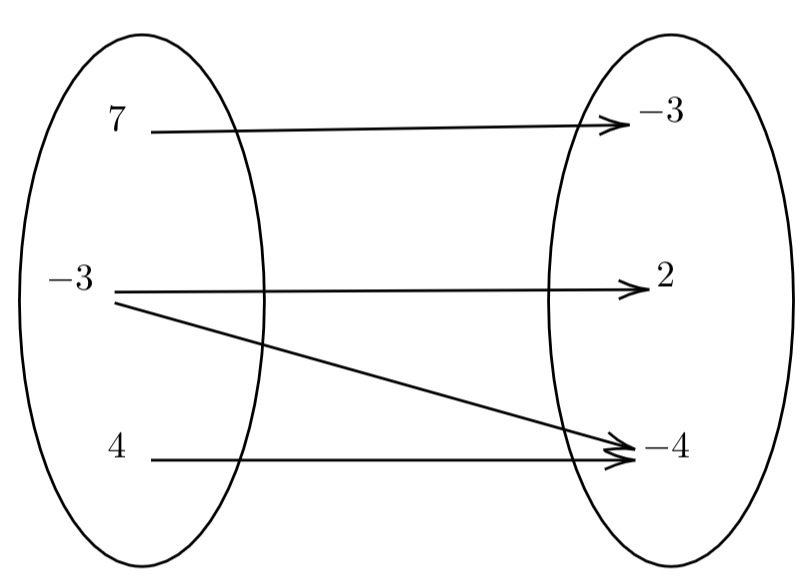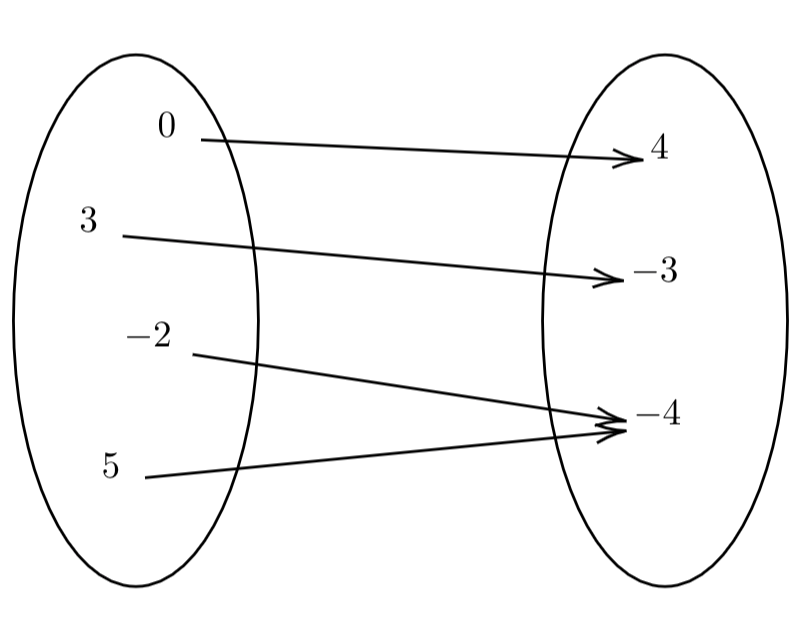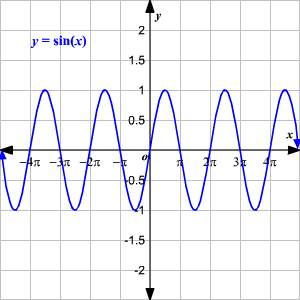AP PRECALC
1/134
Earn XP
Description and Tags
terms and formulas
Name | Mastery | Learn | Test | Matching | Spaced |
|---|
No study sessions yet.
135 Terms
Relations
2 different quantities and how they relate to one another
represented by a diagram, equation, or list
can be written out in ordered pairs for diagram
not all elements have to be used
some inputs have multiple outputs which makes it NOT a function
relation ≠ function; function = relation

function
relation that maps a set of input values to set of output values
can be represented verbally, numerically, algebraically, and graphically
variable representing INPUT values: INDEPENDENT
Variable representing OUTPUT values: DEPENDENT
function = relation; relation ≠ function

Domain
largest possible set of numbers that can be an input (x) for which the output (f(x)) is a real number
x-axis
furthest left= lower bound
furthest right= upper bound
range
set of all values y can have as x takes on each its values
filled dot vs hollow dot
Filled dot → includes value in the domain or range
Hollow dot -→ does not include value
inflection points
NOT the same thing as turning points
it is where concavity changes from up to down or vise versa
turning points
where the value of the change of the function changes sign- increasing to decreasing or vice versa
occurs at the minimum or maximum (ex: vertex of parabola)
interval notation- using [-,-] and (-,-)
[-,-] includes value(s)
(-,-) does not include value(s)
use U in between for ‘union’
Domain restrictions
Denominator≠0
Can’t take square root of negative number
X and Y intercepts
X-intercept: when f(x)= 0
zeros, solution
Y-intercept: when x=0
A function can have more than 1 x-intercept but can only have 1 y-intercept
Average rate of change
change in one value of one quantity divided by change in value of another quantity
average speed= change in distance/change in time
slope= deltay/deltax=(y2-y1)/(x2-x1)
It is impossible to find average rate of change given one point but to approximate, choose points close to that given point to calculate slope with given slope to create secant line to approach similar value
slope- intercept form
y=mx+b
point-slope formula
y2-y1=m(x2-x1)
standard form of quadratic function (parabola)
ax² + bx + c = 0
Rate of Change of Quadratic Funtion
determine average rate of change by finding slope of segment that connects to 2 points on parabola (finding slope of secant)
Polynomial functions
always written in descending order
if exponents are NOT a whole number→ it is NOT a polynomial function
Number of solutions/zeros/x intercepts of a function (real and non real)
= Degree of function
= Degree of function
Sine/ Sin
Opposite / hypotenuse
Cosine/Cos
Adjacent / Hypotenuse
Tangent/ Tan
Opposite / Adjacent
Y/x
sin/cos
Csc- cosecant
Reciprocal of sin
Hyp. / opposite
1/sin
Sec- secant
Reciprocal of cos
Hyp. / adjacent
1/cos
Cot- cotangent
Reciprocal of tangent
Cos/sin
x/y
Vertical translation
F(x)—> f(x) +d
(x,y)—> (x,y+d)
Up (positive) or down (negative)
Horizontal Translation
F(x) -> f(x-c)
(x,y) -> (x-c,y)
Right (negative) or left (positive)
Vertical Stretch/ Compression (Dialation)
F(x) —> af(x)
(x,y)—>(x,ay)
If a> 1 : stretch
If 0>a>1 : compression
Reflection over x-axis
F(x) —> -f(x)
(x,y) → (x,-y)
Reflection over y axis
F(x) —> f(-x)
(x,y) → (-x,y)
Horizontal stretch/ compression/ dialation
f(x)—> f(kx)
(x/k,y)
k>1 compression
0<k<1 stretch
Composite Funtion
A function that is made up of combination of transformations
y=af(b(x+c))+d
a- vertical stretch/compression
b- horizontal stretch/compression
c- horizontal shift
d- vertical shift
Imaginary number-i
powers of i
i=√-1
i2=-1
i3=i2(i)=-i
i4=i2(i2)= -1(-1)=1
powers continue following pattern
adding with i
add coefficients
2i+3i=5i
subtracting with i
subtract coefficients
7i-3i=4i
multiplication with i
multiply coefficients, add exponents
2i(5i)=10i2
division with i
exponents are subtracted
coefficients are divided
49i5/7i3= 7i2=-7
negative exponent
take reciprocal
ex. 2-2=1/22=1/4
fractional exponent
take root
ex. 82/3=3√82= 3√64=4
xm(xn)
xm+n
Sum of exponents
(xm)n
xm(n)
Product of exponents
rational exponent law: ax/y
=y√(ax) =(y√a)x
45 45 90 triangle
side 1- a
side 2- a
hypotenuse-√2
30 60 90 triangle
side 1- a
side 2- a√3
hypotenuse- 2a
law of sines
side of triangle ABC/sine of angle opposite side
= a/sinA
=b/sinB
=c/sinC
law of cosines
a² = b² + c² - 2bc cosA
b² = a² + c² - 2ac cosB
c² = a² + b² - 2ab cosC
Function tests
Vertical line test- Is it a function
Horizontal line test- Is it one to one?
if not, the function does not have an inverse
Extreme Value Theorem
If a polynomial function f is on a closed interval [a,b] then f has both a minimum and maximum value on [a,b]
Local extrema theorem
A polynomial function of degree n has at most n-1 realtive maxima/minima
ex. ±x2→has one (2-1) max/min.
Absolute extrema
can occur at either relative extrema or at endpoints of CLOSED interval
Zeros (real and complex)
on x-axis
when equation is set to 0 (when y=0)
polynomial function of degree n will have exactly n total zeros (real and nonreal)
Quadratic real roots
if discriminant ( -b2-4ac) is…
>0 → 2 real roots
=0 →1 real root
<0→no real roots
nonreal zero of polynomial
If a+bi is a nonreal zero of a polynomial p. its conjugate a-bi is also a zero of p
even function
if equation remains unchanged when x is replaced with negative x
f(-x)=f(x) for all x
symmetrical to y axis
odd function
if replacing x with -x changed sign of each term of the equation to its opposite
when f(-x)=-f(x)
End behavior of all polynomial functions
positive leading coefficient & even degree:
limx→∞p(x) =∞
limx→−∞p(x) =∞
positive leading coefficient & odd degree:
limx→∞p(x) =∞
limx→−∞p(x) =−∞
negative leading coefficient & even degree:
limx→∞p(x) =−∞
limx→−∞p(x) =−∞
negative leading coefficient & odd degree:
limx→∞p(x) =−∞
limx→−∞p(x) =∞
Positive leading coefficient & even degree end behavior:
limx→∞p(x) =∞
limx-→−∞p(x) =∞
positive leading coefficient & odd degree end behavior:
limx→∞p(x) =∞
limx→−∞p(x) =−∞
negative leading coefficient & even degree end behavior:
limx→∞p(x) =−∞
limx→−∞p(x) =−∞
negative leading coefficient & odd degree end behavior:
limx→∞p(x) =−∞
limx→−∞p(x) =∞
rational function
represented as quotient of 2 polynomial functions
ex. h(x)=f(x)/(g(x)
may be discontinuous (have breaks in the graph)-→ asymptotes and holes
can model data sets/scenarios including quantities that are inversely proportional
vertical asymptote
when a rational function is undefined from an x value
when an x value makes the denominator= 0 (cannot divide by 0)
horizontal asymptote (end behavior asymptote) rules
if numerator degree< denominator degree, y=0
if numerator degree = denominator degree, y = leading coefficient ratio
if numerator degree> denominator degree by exactly 1, slant/oblique asymptote
if numerator degree > denominator degree by MORE than 1, no horizontal asymptote
*IT IS POSSIBLE FOR A GRAPH OF RATIONAL FUNCTION TO INTERSECT A HORIZONTAL ASYMPTOTE OR SLANT ASYMPTOTE BUT IT WILL NEVER CROSS VERTICAL ASYMPTOTE*
linear parent function
f(x)=x
Domain and Range set of real numbers
odd function→ has origin symmetry
includes point (0,0)
increases throughout domain
Models data sets/scenarios that demonstrate constant rates of change
Quadratic parent function
f(x)=x2
Domain and Range set of real numbers
even function→ has y-axis symmetry
includes point (0,0)
decreases then increases
has relative extrema
model data sets/scenarios that demonstrate linear rates of change (ex. area or 2D)
Cubic function parent function
f(x)=x3
Domain and range is set of real numbers
odd function→ has origin symmetry
includes point (0,0)
increases throughout domain
Model geometric contexts involving volume or 3D
square root parent function
f(x)=√x
domain and range is set of all positive real numbers
neither negative or even fuction
includes point (0,0)
increases throughout its domain.
reciprocal parent function
f(x)= 1/x
Domain and range is all real numbers except 0;
Odd function→origin symmetry
x-axis and y-axis are asymptotes
decreases on intervals (-∞, 0) and (0,∞)
absolute value parent function
f(x)=|x|
Domain is set of real numbers
odd function→ has origin symmetry
includes point (0,0)
decreases then increases
sine function- even or odd?
odd function
symmetrical about the origin
cosine function- even or odd?
even function
symmetrical about the y-axis
identity function
the composition of a function f and its inverse function f-1 is the identity function
f(f-1(x))=f-1((f(x))
composite function
functions linked to form new function by using output of one function as the input in other function as the input to the other function
Inverse functions
given function f(x), if f(a)=b, then f-1(b)=a
if function consists of input-output pairs (a,b) the inverse function consists of input-output pairs (b,a)
one-to-one check→ using horizontal line test; if any 2 different inputs in domain correspond to two different outputs in range then it is one-to-one
not one-to-one if two different inputs correspond to the same output, it does not have an inverse
algebraically solving inverse functions- swap x and y values
inverse of each other test
if f(g(x))=x and g(f(x))=x then they are inverses of each other
exponential functions
general form- f(x)= abx
where a= initial value; a≠0
b=base; b>0, b≠0; also the growth factor/rate
domain is all real numbers, range is (0,-∞)
y-intercept is (0,1)
horizontal asymptote at y=0
when a>0 and b>1→ exponential growth
when a>0 and 0>b>1→ exponential decay
does not have extrema unless on closed interval
when a>0 and b>0→ concave up
when a<0 and b<1→ concave down
does not have inflection points
end behavior possibilities:
lim x→± ∞ f(x)= ∞
lim x→ ± ∞ f(x)= -∞
lim x→ ± ∞ f(x)= 0
Exponential growth
when a>0 and b>1
when given a rate in % for word problems, add one to growth factor (decimal form)
ex a(1+r)x
Exponential decay
when a>0 and 0>b>1
when given a rate in % for word problems, subtract growth factor from one
ex a(1-r)x
sequence vs. series
sequence= a list of numbers in a specific order
series= the sum of the terms of a sequence.
Residuals
observed value- predicted value from regression equation
residual plot: graph that shows residuals on vertical axis and the independent variable on horizontal axis
if there is a pattern, then that regression DOES NOT model the data; if it is random then it DOES
Arithmetic sequence
linear
an=a1+ (n-1)d
if the first term is correlated with n=0, the nth term of sequence can be written as an=a0+d(n)
use an= ak+(n-k)d if a1 or a0 is unknown
Geometric Sequence
exponential function
where each term after the first is obtained by multiplying by the same number (ratio)
gn=g1r(n-1)
gn=gkr(n-k)
if first term is correlated with n=0 use gn=g0rn
change of base- logs
logbx=logx/logb
for other bases that are not 10 use: logbx=logax/logab
exponential and logarithmic identities
logbbx=x
blogbx==x
generalizations of logarithmic functions graph
domain is limited to set of positive real numbers
range is set to all real numbers
x- intercept is at (1,0)
no y-intercept
vertical asymptote at x=0 (y-axis)
if base is greater than 1, graph rises as x increases
As x decreases, the graph is asymptotic to negative y-axis
if base is between 0 and 1, the graph falls as x increases is asymptotic to the positive y-axis
graph of y=bx
Quadrants: I and II
Domain: (-∞, ∞)
Range: (0,∞)
x-intercept: None
y- intercept: (0,1)
Asymptote: x-axis
rises as x increases: b>1
falls as x increases if 0 < b < 1
graph of y=logbx
Quadrants: I and IV
Domain: (0,∞)
Range: (-∞, ∞)
x-intercept: (1,0)
y-intercept: None
Asymptote: y-axis
rises as x increases if b>1
falls as x increases if 0
log functions are always increasing or decreasing and their graphs are either always concave up or concave down so they don’t have extrema except when on a closed interval. they also dont have inflection points
product law of log
logb(xy)=logbx+ logby
quotient law of log
logb(x/y)=logbx - logby
power law of log
logb(xn)=nlogb(x)
ln1=?
0
lne=?
1
lnex=?
x
solving log equation when eah term has same base
rewrite each side as single log
write equation without logarithms using one-to-one function property: logbA=logbB→ A=B
ex. if log5N= 3log5x+ log5y solve for N
log5N=log5(x3)+ log5y
log5N=log5(x3/y)
log5 cancels out→ N=x3y
solving log equation containing constant term
bring all logarithms with same base to same side of the equation
write equation in logarithmic form logbc=a
write equation in exponential form and solve
check solution with original equation
linearizing exponential data
start with general form of exponential function: y=aekx
take natural log of both sides: lny=ln(aekx)
use log properties:
lny=lna +lnekx
lny=lna + kxlne
lny=lna+kx
periodic phenomena
occur in physical world ex. seasonal variations, # of daylight hours, phases of moon, etc.
each complete pattern of values→ cycles
behaviors of periodic functions
period can be estimated by investigating successive equal-length output values and finding where the pattern begins and repeats
intervals found in one period of periodic function where function increases, decreases, is concave up or is concave down will be in every period of the function
Trig funcitons
periodic functions
dependent on angle measures
if terminal side rotates counterclockwise→ angle is positive
if terminal side rotates counterclockwise→ angle is negative
radian + degree conversion
degrees→ radian
x ⋅ π/180
radian→ degrees
x ⋅ 180/π
coterminal angles
angels in standard position that share a terminal ray
sin funciton
